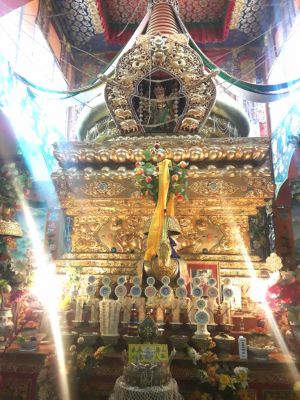Karma Kagyu Kālacakra Masters and the Bokar Rinpoche Kālacakra Stupa
Having spent the last ten days in the presence of three great living masters of Kālacakra, HE 12th Gyaltsab Rinpoche, Bokar Yangsi (whose predecessor was the great Bokar Rinpoche) and Khenpo Lodro Donyo Rinpoche at Bokar Monastery, Mirik for the several empowerments and Red Hat Ceremony of Karma Kagyu Heart Son, 12th Gyaltsab Rinpoche, I was reminded of how the Karma Kagyu lineage have also kept the Kālacakra practices and teachings alive and well.
On the Kālacakra Duchen, two major Karma Kagyu monasteries, Bokar Monastery and Rumtek Monastery performed Kālacakra rituals and creation of sand Mandala and HE 12th Gyaltsab Rinpoche gave the Kālacakra empowerment at his Ralang monastery.
Visiting the Golden Relic Kālacakra Stupa of the former Bokar Rinpoche at Bokar Monastery, which was finished in 2006, was an inspiring experience. The Stupa itself has a Kālacakra image at the top and surrounding it are exquisitely painted images of the Kālacakra deity and all the individual deities in the Mandala (see photos below). It reminded me a little of the beautiful Kālacakra temple in Dharamsala, India.
According to the late Edward Henning:
The situation with regard to the Karma Kagyu school is rather odd. That tradition’s Kālacakra practices originally came from the translator Tsami (tsa mi lo tsā ba), and passed through the siddha Ogyenpa (o rgyan pa), and then to the third Karmapa, Rangjung Dorje (rang byung rdo rje). From him it was passed down
the Karma Kagyu lineage. However, the use of the practice texts of this tradition, the most notable being written by the eighth Karmapa, Mikyo Dorje (mi bskyod rdo rje), has largely ceased, and the practices of the Jonang tradition written by Tāranātha are now mainly used. But still the maṇḍala is drawn according to
the original Karma Kagyu methods (which I will refer to as the Tsami tradition), even though there are some clear, although minor, contradictions between the descriptions given in the maṇḍala drawing texts and the practice texts. These differences have sometimes caused puzzlement to modern Karma Kagyu maṇḍala artists, unaware of the full history of their tradition.
The Kālacakra tradition now practiced in the Karma and Shangpa Kagyu schools is derived from the Jonang tradition and was largely systematized by Jamgon Kongtrul, who wrote the text that is now used for
empowerment. The 2nd and 3rd Jamgon Kongtrul (1954–1992) were also prominent Kālacakra lineage holders, with the 3rd Jamgon Kongtrul giving the initiation publicly in North America on at least one occasion (Toronto 1990).
The chief Kālacakra lineage holder for the Kagyu lineage was Kalu Rinpoche (1905–1990), who gave the initiation several times in Tibet, India, Europe and North America (e.g., New York 1982). Upon his death,
this mantle was assumed by his heart son, Bokar Rinpoche, who in turn passed it on to Khenpo Lodro Donyo Rinpoche. Bokar Monastery, of which Donyo Rinpoche is now the head, features a Kālacakra stupa and is a prominent retreat center for Kālacakra practice in the Kagyu lineage.
Tenga Rinpoche was also a prominent Kagyu holder of the Kālacakra; he gave the initiation in Grabnik, Poland in August, 2005.
Lopon Tsechu performed Kālacakra initiations and built a Kālacakra stupa in Karma Guen buddhist center in southern Spain. Another prominent Kālacakra master is the Second Beru Khyentse.
Chögyam Trungpa, while not a noted Kālacakra master, became increasingly involved later in his life with what he termed Shambhala teachings, derived in part from the Kālacakra tradition, in particular, the mind terma which he received from the Kalki.
Here is a list of contemporary Kalacakra Masters who teach and give empowerments outside of Tibet, many of whom are Kagyu lineage holders: http://kalachakranet.org/kalachakra_tantra_masters.html
Source
[[1]]
